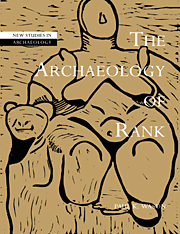Book contents
- Frontmatter
- Contents
- List of figures and tables
- Acknowledgments
- 1 The present study of past society
- 2 Social theory and social life: models of society in the archaeological study of status
- 3 Inequality and social life: a working model
- 4 Mortuary data as evidence of ranking, Part 1
- 5 Mortuary data as evidence of ranking, Part 2
- 6 The form and distribution of artifacts
- 7 Status, settlements, and structures
- 8 Çatal Hüyük: a ranked Neolithic town in Anatolia?
- Notes
- References
- Index
- NEW STUDIES IN ARCHAEOLOGY
3 - Inequality and social life: a working model
Published online by Cambridge University Press: 22 August 2009
- Frontmatter
- Contents
- List of figures and tables
- Acknowledgments
- 1 The present study of past society
- 2 Social theory and social life: models of society in the archaeological study of status
- 3 Inequality and social life: a working model
- 4 Mortuary data as evidence of ranking, Part 1
- 5 Mortuary data as evidence of ranking, Part 2
- 6 The form and distribution of artifacts
- 7 Status, settlements, and structures
- 8 Çatal Hüyük: a ranked Neolithic town in Anatolia?
- Notes
- References
- Index
- NEW STUDIES IN ARCHAEOLOGY
Summary
“To an anthropologist,” said Andre Beteille, “… the idea of natural inequality is inherently ambiguous, if not a contradiction in terms” (1981:59–60). Certainly there are great differences among people, many of which have both “natural” and “socially constructed” dimensions, but these are not elements of inequality “unless they are selected, marked out, and evaluated by processes that are cultural and not natural” (Beteille 1981:60). “Equality” and “inequality” are ideas, and as fundamental notions of how the world is ordered, have important implications for how we relate to each other. Ideas about who is “better” than whom and in what ways, deeply influence practice.
Inequality as an instituted process
There are many ways in which people have defined themselves as unequal, and out of the major dimensions of inequality, Gerald Berreman has developed a “typology for a comparative study of social inequality” (1981:4; Table 1.4). This is an excellent starting point for considering what it is we intend to look for in the archaeological study of rank. The human condition is characterized by differentiation. Inequality “refers to the social evaluation of whatever differences are regarded as relevant in a given society or situation” (Berreman 1981:8), while social inequality is generally a combination of inequality with dominance, “the behavioral expression of those differences” (p8).
- Type
- Chapter
- Information
- The Archaeology of Rank , pp. 36 - 66Publisher: Cambridge University PressPrint publication year: 1994



